T05101: Analyzing Wildlife Tourism Trends and Future Scenarios
VerifiedAdded on 2023/06/07
|19
|4149
|101
Report
AI Summary
This report provides a comprehensive analysis of wildlife tourism, focusing on current trends and future scenarios. It employs a STEEP analysis to examine social, technological, economic, ecological, and political factors influencing the industry. The report discusses the rising awareness and income levels driving social support, technological advancements enhancing accessibility and safety, economic factors like revenue generation and currency exchange rates, ecological considerations for conservation, and the impact of natural disasters. Three future scenarios are developed, addressing risk management, natural calamities, and government collaboration, each critically assessed for challenges and stakeholder implications. The report concludes by emphasizing the importance of sustainable practices and adaptive strategies for the continued growth and resilience of wildlife tourism. Desklib offers this report as a valuable resource for students, alongside a wide range of other solved assignments and past papers.
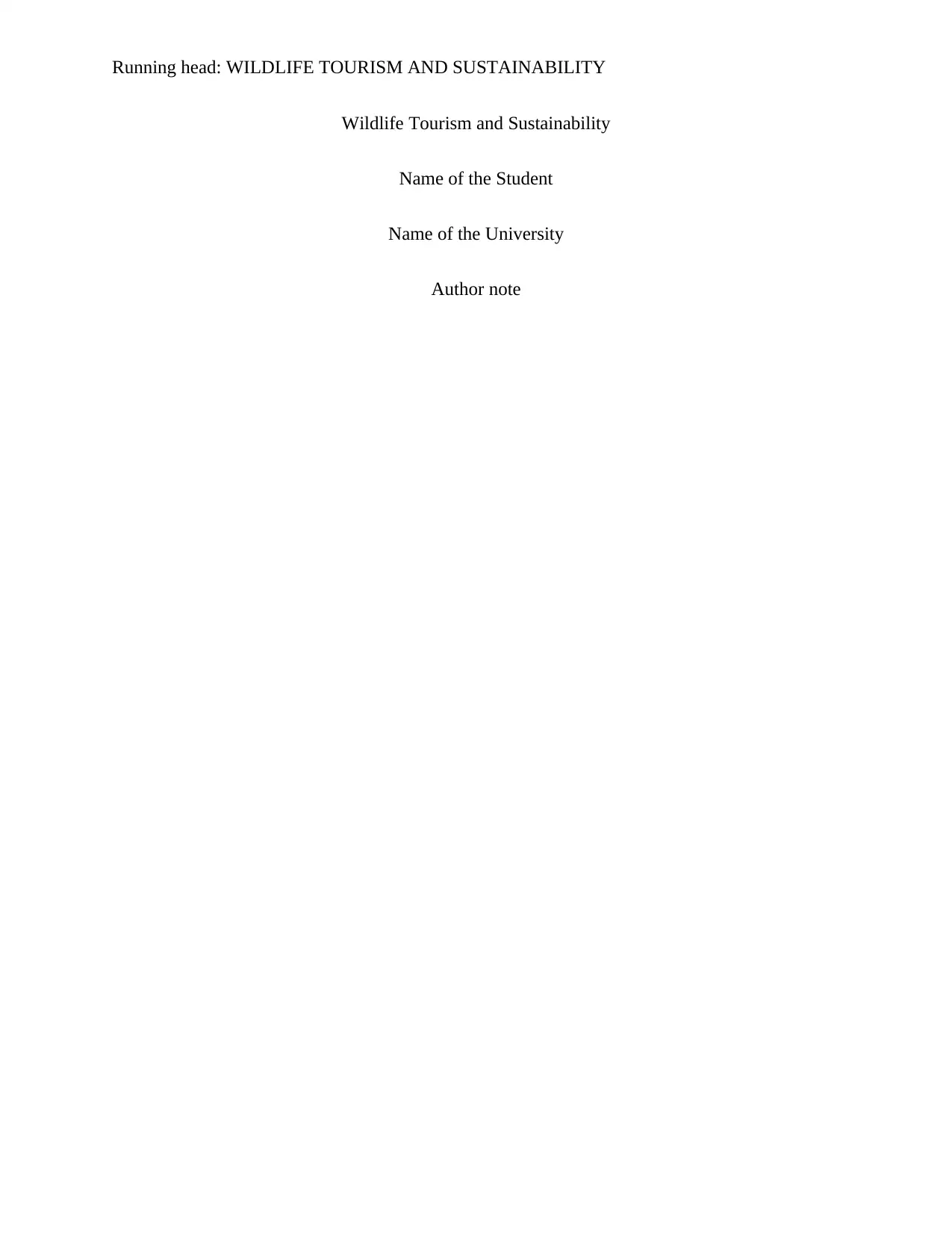
Running head: WILDLIFE TOURISM AND SUSTAINABILITY
Wildlife Tourism and Sustainability
Name of the Student
Name of the University
Author note
Wildlife Tourism and Sustainability
Name of the Student
Name of the University
Author note
Paraphrase This Document
Need a fresh take? Get an instant paraphrase of this document with our AI Paraphraser
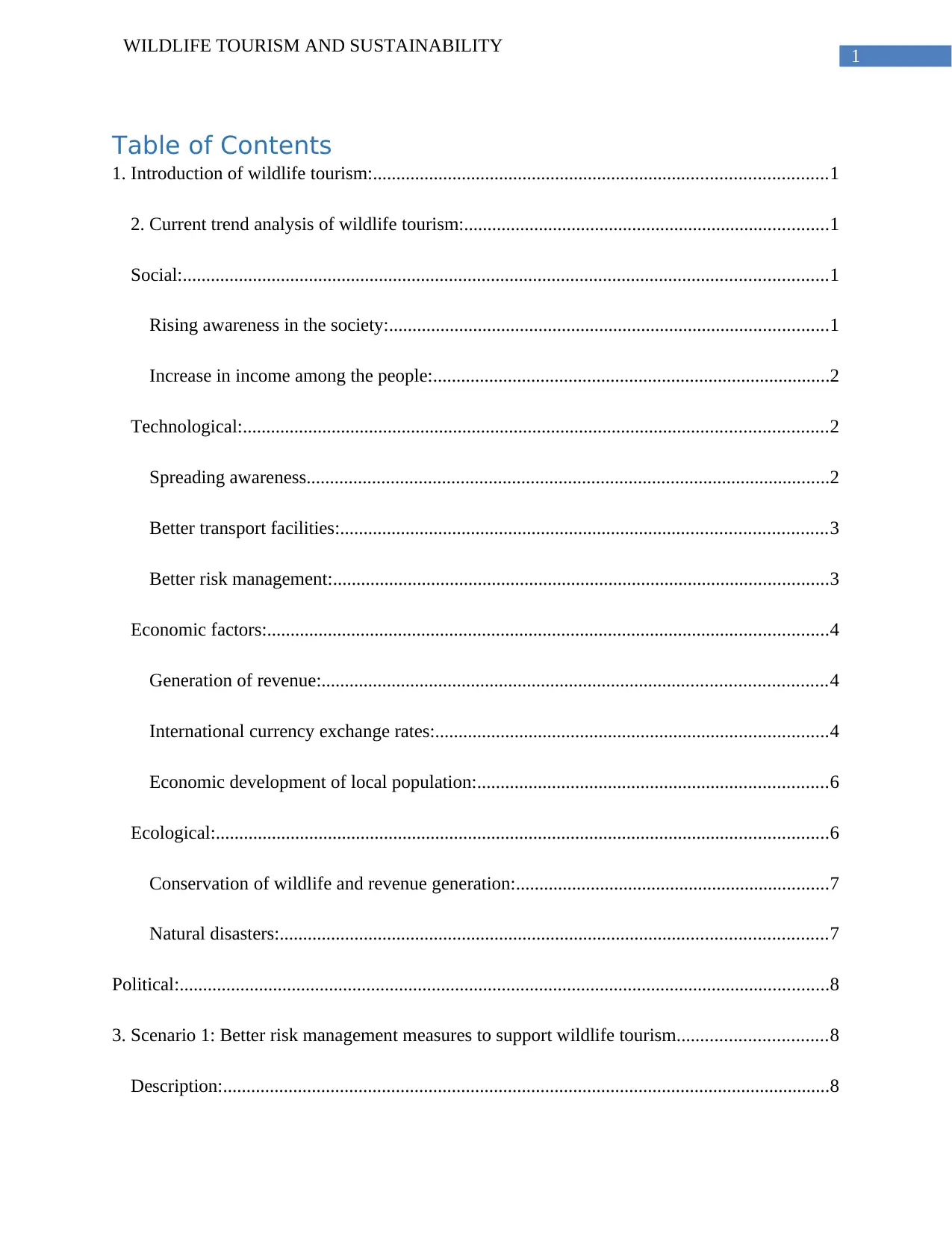
1
WILDLIFE TOURISM AND SUSTAINABILITY
Table of Contents
1. Introduction of wildlife tourism:.................................................................................................1
2. Current trend analysis of wildlife tourism:..............................................................................1
Social:..........................................................................................................................................1
Rising awareness in the society:..............................................................................................1
Increase in income among the people:.....................................................................................2
Technological:.............................................................................................................................2
Spreading awareness................................................................................................................2
Better transport facilities:........................................................................................................3
Better risk management:..........................................................................................................3
Economic factors:........................................................................................................................4
Generation of revenue:............................................................................................................4
International currency exchange rates:....................................................................................4
Economic development of local population:...........................................................................6
Ecological:...................................................................................................................................6
Conservation of wildlife and revenue generation:...................................................................7
Natural disasters:.....................................................................................................................7
Political:...........................................................................................................................................8
3. Scenario 1: Better risk management measures to support wildlife tourism................................8
Description:..................................................................................................................................8
WILDLIFE TOURISM AND SUSTAINABILITY
Table of Contents
1. Introduction of wildlife tourism:.................................................................................................1
2. Current trend analysis of wildlife tourism:..............................................................................1
Social:..........................................................................................................................................1
Rising awareness in the society:..............................................................................................1
Increase in income among the people:.....................................................................................2
Technological:.............................................................................................................................2
Spreading awareness................................................................................................................2
Better transport facilities:........................................................................................................3
Better risk management:..........................................................................................................3
Economic factors:........................................................................................................................4
Generation of revenue:............................................................................................................4
International currency exchange rates:....................................................................................4
Economic development of local population:...........................................................................6
Ecological:...................................................................................................................................6
Conservation of wildlife and revenue generation:...................................................................7
Natural disasters:.....................................................................................................................7
Political:...........................................................................................................................................8
3. Scenario 1: Better risk management measures to support wildlife tourism................................8
Description:..................................................................................................................................8
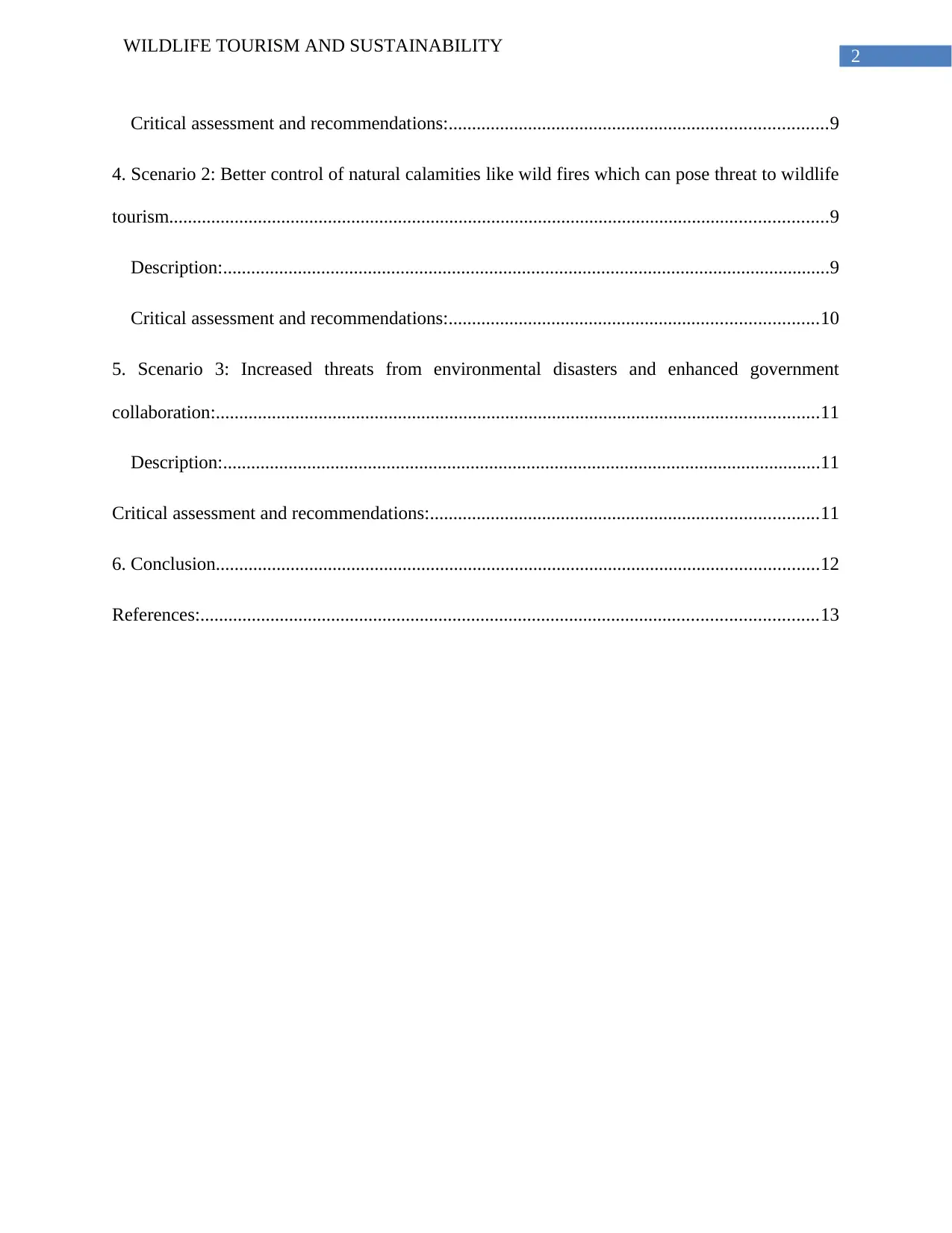
2
WILDLIFE TOURISM AND SUSTAINABILITY
Critical assessment and recommendations:.................................................................................9
4. Scenario 2: Better control of natural calamities like wild fires which can pose threat to wildlife
tourism.............................................................................................................................................9
Description:..................................................................................................................................9
Critical assessment and recommendations:...............................................................................10
5. Scenario 3: Increased threats from environmental disasters and enhanced government
collaboration:.................................................................................................................................11
Description:................................................................................................................................11
Critical assessment and recommendations:...................................................................................11
6. Conclusion.................................................................................................................................12
References:....................................................................................................................................13
WILDLIFE TOURISM AND SUSTAINABILITY
Critical assessment and recommendations:.................................................................................9
4. Scenario 2: Better control of natural calamities like wild fires which can pose threat to wildlife
tourism.............................................................................................................................................9
Description:..................................................................................................................................9
Critical assessment and recommendations:...............................................................................10
5. Scenario 3: Increased threats from environmental disasters and enhanced government
collaboration:.................................................................................................................................11
Description:................................................................................................................................11
Critical assessment and recommendations:...................................................................................11
6. Conclusion.................................................................................................................................12
References:....................................................................................................................................13
⊘ This is a preview!⊘
Do you want full access?
Subscribe today to unlock all pages.

Trusted by 1+ million students worldwide
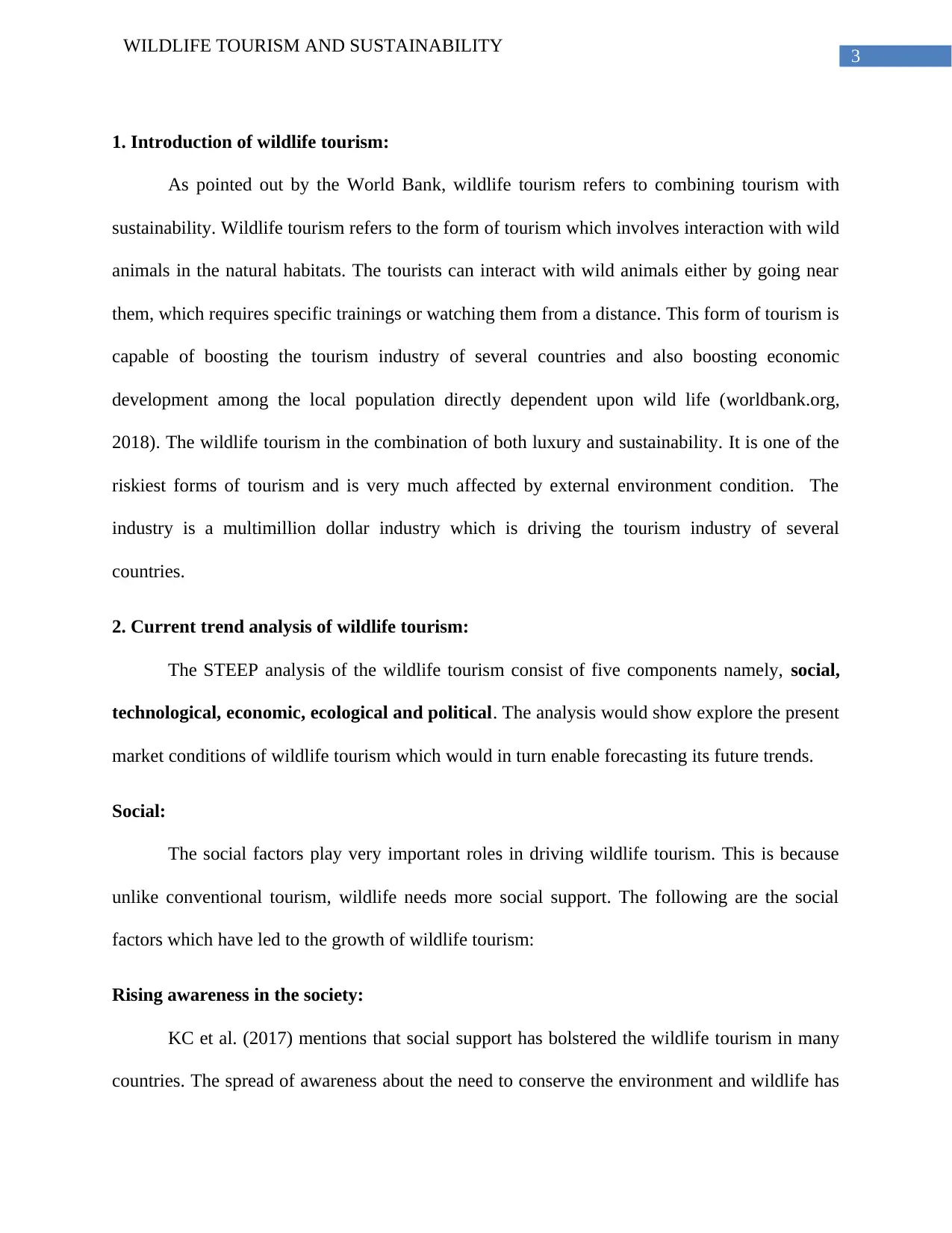
3
WILDLIFE TOURISM AND SUSTAINABILITY
1. Introduction of wildlife tourism:
As pointed out by the World Bank, wildlife tourism refers to combining tourism with
sustainability. Wildlife tourism refers to the form of tourism which involves interaction with wild
animals in the natural habitats. The tourists can interact with wild animals either by going near
them, which requires specific trainings or watching them from a distance. This form of tourism is
capable of boosting the tourism industry of several countries and also boosting economic
development among the local population directly dependent upon wild life (worldbank.org,
2018). The wildlife tourism in the combination of both luxury and sustainability. It is one of the
riskiest forms of tourism and is very much affected by external environment condition. The
industry is a multimillion dollar industry which is driving the tourism industry of several
countries.
2. Current trend analysis of wildlife tourism:
The STEEP analysis of the wildlife tourism consist of five components namely, social,
technological, economic, ecological and political. The analysis would show explore the present
market conditions of wildlife tourism which would in turn enable forecasting its future trends.
Social:
The social factors play very important roles in driving wildlife tourism. This is because
unlike conventional tourism, wildlife needs more social support. The following are the social
factors which have led to the growth of wildlife tourism:
Rising awareness in the society:
KC et al. (2017) mentions that social support has bolstered the wildlife tourism in many
countries. The spread of awareness about the need to conserve the environment and wildlife has
WILDLIFE TOURISM AND SUSTAINABILITY
1. Introduction of wildlife tourism:
As pointed out by the World Bank, wildlife tourism refers to combining tourism with
sustainability. Wildlife tourism refers to the form of tourism which involves interaction with wild
animals in the natural habitats. The tourists can interact with wild animals either by going near
them, which requires specific trainings or watching them from a distance. This form of tourism is
capable of boosting the tourism industry of several countries and also boosting economic
development among the local population directly dependent upon wild life (worldbank.org,
2018). The wildlife tourism in the combination of both luxury and sustainability. It is one of the
riskiest forms of tourism and is very much affected by external environment condition. The
industry is a multimillion dollar industry which is driving the tourism industry of several
countries.
2. Current trend analysis of wildlife tourism:
The STEEP analysis of the wildlife tourism consist of five components namely, social,
technological, economic, ecological and political. The analysis would show explore the present
market conditions of wildlife tourism which would in turn enable forecasting its future trends.
Social:
The social factors play very important roles in driving wildlife tourism. This is because
unlike conventional tourism, wildlife needs more social support. The following are the social
factors which have led to the growth of wildlife tourism:
Rising awareness in the society:
KC et al. (2017) mentions that social support has bolstered the wildlife tourism in many
countries. The spread of awareness about the need to conserve the environment and wildlife has
Paraphrase This Document
Need a fresh take? Get an instant paraphrase of this document with our AI Paraphraser
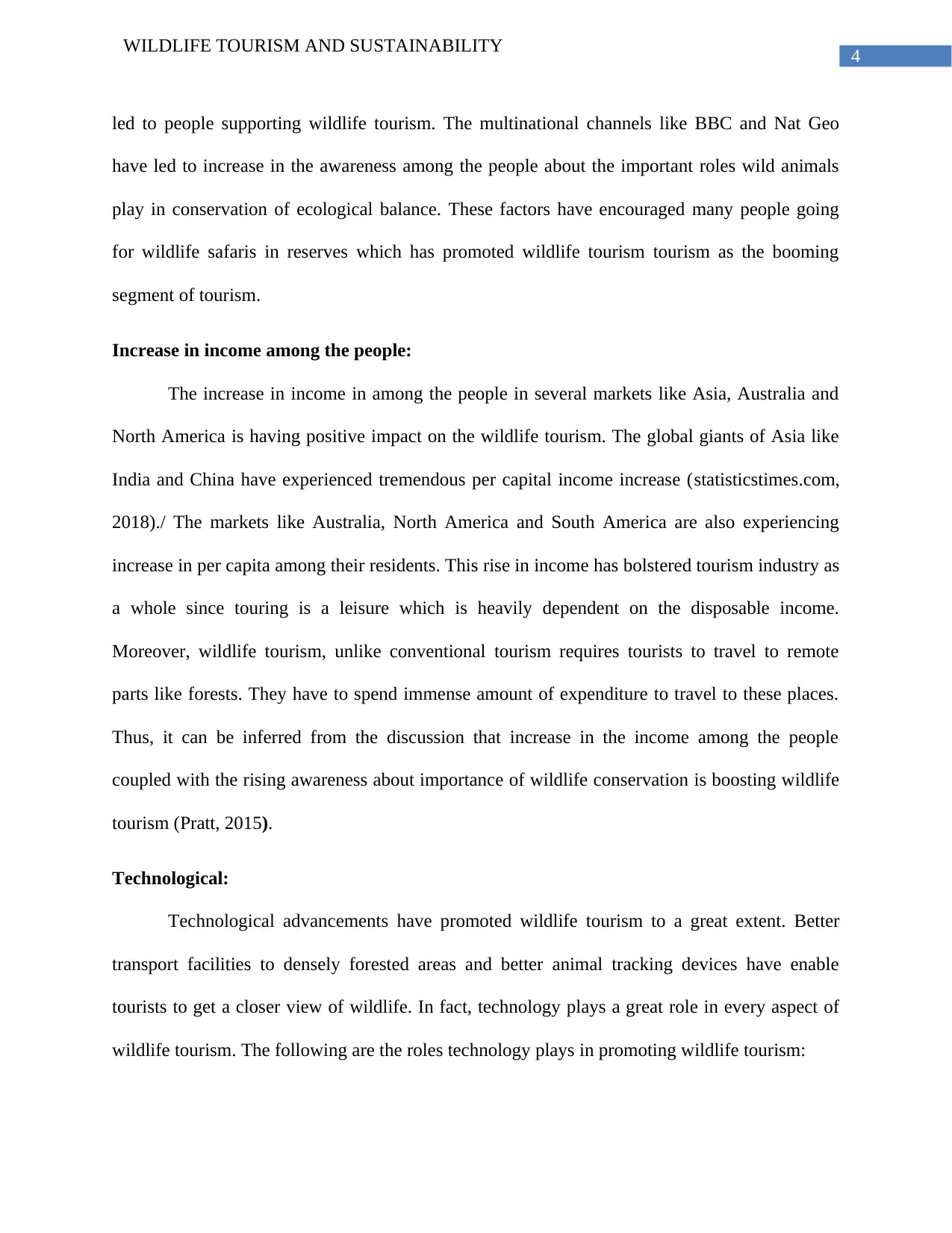
4
WILDLIFE TOURISM AND SUSTAINABILITY
led to people supporting wildlife tourism. The multinational channels like BBC and Nat Geo
have led to increase in the awareness among the people about the important roles wild animals
play in conservation of ecological balance. These factors have encouraged many people going
for wildlife safaris in reserves which has promoted wildlife tourism tourism as the booming
segment of tourism.
Increase in income among the people:
The increase in income in among the people in several markets like Asia, Australia and
North America is having positive impact on the wildlife tourism. The global giants of Asia like
India and China have experienced tremendous per capital income increase (statisticstimes.com,
2018)./ The markets like Australia, North America and South America are also experiencing
increase in per capita among their residents. This rise in income has bolstered tourism industry as
a whole since touring is a leisure which is heavily dependent on the disposable income.
Moreover, wildlife tourism, unlike conventional tourism requires tourists to travel to remote
parts like forests. They have to spend immense amount of expenditure to travel to these places.
Thus, it can be inferred from the discussion that increase in the income among the people
coupled with the rising awareness about importance of wildlife conservation is boosting wildlife
tourism (Pratt, 2015).
Technological:
Technological advancements have promoted wildlife tourism to a great extent. Better
transport facilities to densely forested areas and better animal tracking devices have enable
tourists to get a closer view of wildlife. In fact, technology plays a great role in every aspect of
wildlife tourism. The following are the roles technology plays in promoting wildlife tourism:
WILDLIFE TOURISM AND SUSTAINABILITY
led to people supporting wildlife tourism. The multinational channels like BBC and Nat Geo
have led to increase in the awareness among the people about the important roles wild animals
play in conservation of ecological balance. These factors have encouraged many people going
for wildlife safaris in reserves which has promoted wildlife tourism tourism as the booming
segment of tourism.
Increase in income among the people:
The increase in income in among the people in several markets like Asia, Australia and
North America is having positive impact on the wildlife tourism. The global giants of Asia like
India and China have experienced tremendous per capital income increase (statisticstimes.com,
2018)./ The markets like Australia, North America and South America are also experiencing
increase in per capita among their residents. This rise in income has bolstered tourism industry as
a whole since touring is a leisure which is heavily dependent on the disposable income.
Moreover, wildlife tourism, unlike conventional tourism requires tourists to travel to remote
parts like forests. They have to spend immense amount of expenditure to travel to these places.
Thus, it can be inferred from the discussion that increase in the income among the people
coupled with the rising awareness about importance of wildlife conservation is boosting wildlife
tourism (Pratt, 2015).
Technological:
Technological advancements have promoted wildlife tourism to a great extent. Better
transport facilities to densely forested areas and better animal tracking devices have enable
tourists to get a closer view of wildlife. In fact, technology plays a great role in every aspect of
wildlife tourism. The following are the roles technology plays in promoting wildlife tourism:
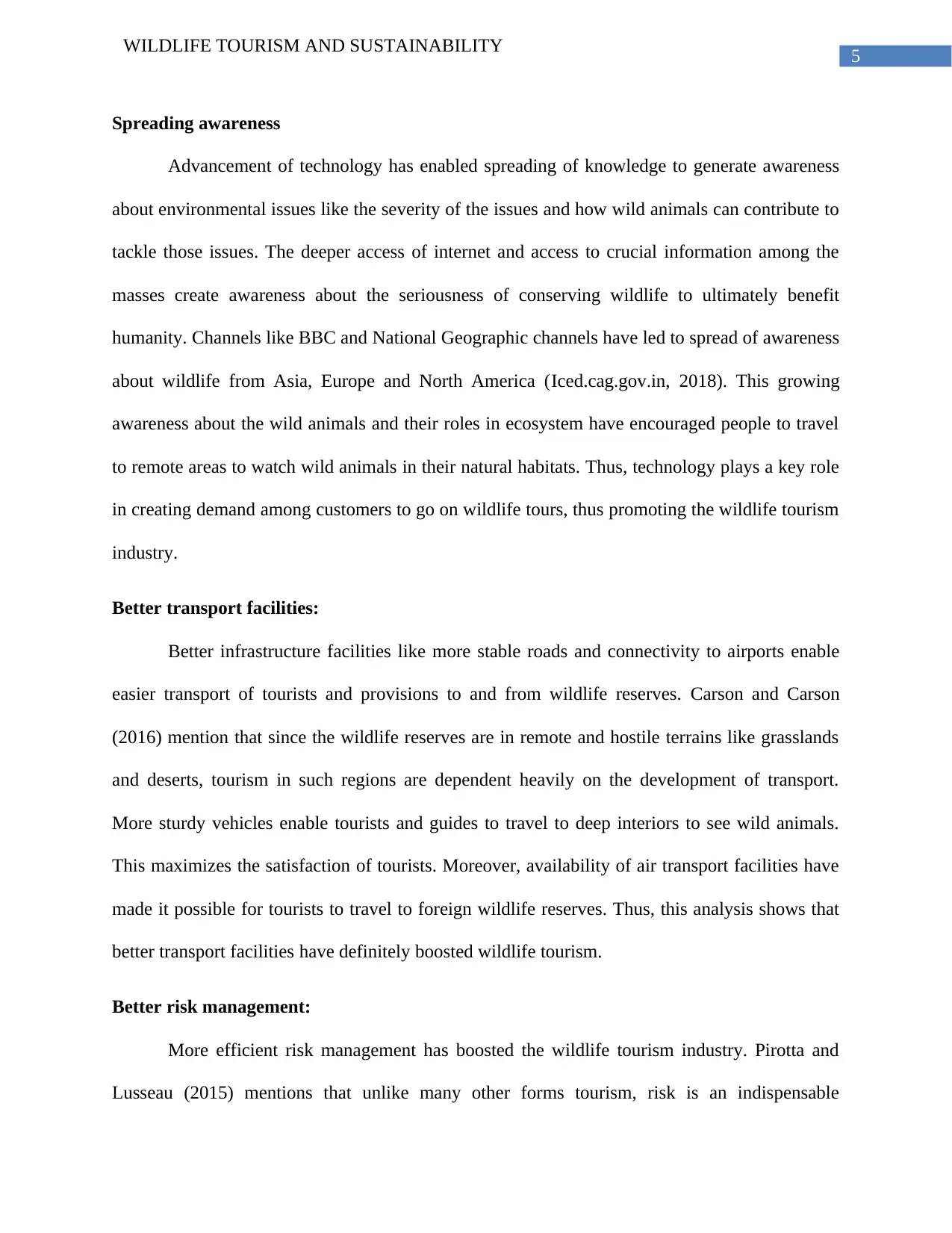
5
WILDLIFE TOURISM AND SUSTAINABILITY
Spreading awareness
Advancement of technology has enabled spreading of knowledge to generate awareness
about environmental issues like the severity of the issues and how wild animals can contribute to
tackle those issues. The deeper access of internet and access to crucial information among the
masses create awareness about the seriousness of conserving wildlife to ultimately benefit
humanity. Channels like BBC and National Geographic channels have led to spread of awareness
about wildlife from Asia, Europe and North America (Iced.cag.gov.in, 2018). This growing
awareness about the wild animals and their roles in ecosystem have encouraged people to travel
to remote areas to watch wild animals in their natural habitats. Thus, technology plays a key role
in creating demand among customers to go on wildlife tours, thus promoting the wildlife tourism
industry.
Better transport facilities:
Better infrastructure facilities like more stable roads and connectivity to airports enable
easier transport of tourists and provisions to and from wildlife reserves. Carson and Carson
(2016) mention that since the wildlife reserves are in remote and hostile terrains like grasslands
and deserts, tourism in such regions are dependent heavily on the development of transport.
More sturdy vehicles enable tourists and guides to travel to deep interiors to see wild animals.
This maximizes the satisfaction of tourists. Moreover, availability of air transport facilities have
made it possible for tourists to travel to foreign wildlife reserves. Thus, this analysis shows that
better transport facilities have definitely boosted wildlife tourism.
Better risk management:
More efficient risk management has boosted the wildlife tourism industry. Pirotta and
Lusseau (2015) mentions that unlike many other forms tourism, risk is an indispensable
WILDLIFE TOURISM AND SUSTAINABILITY
Spreading awareness
Advancement of technology has enabled spreading of knowledge to generate awareness
about environmental issues like the severity of the issues and how wild animals can contribute to
tackle those issues. The deeper access of internet and access to crucial information among the
masses create awareness about the seriousness of conserving wildlife to ultimately benefit
humanity. Channels like BBC and National Geographic channels have led to spread of awareness
about wildlife from Asia, Europe and North America (Iced.cag.gov.in, 2018). This growing
awareness about the wild animals and their roles in ecosystem have encouraged people to travel
to remote areas to watch wild animals in their natural habitats. Thus, technology plays a key role
in creating demand among customers to go on wildlife tours, thus promoting the wildlife tourism
industry.
Better transport facilities:
Better infrastructure facilities like more stable roads and connectivity to airports enable
easier transport of tourists and provisions to and from wildlife reserves. Carson and Carson
(2016) mention that since the wildlife reserves are in remote and hostile terrains like grasslands
and deserts, tourism in such regions are dependent heavily on the development of transport.
More sturdy vehicles enable tourists and guides to travel to deep interiors to see wild animals.
This maximizes the satisfaction of tourists. Moreover, availability of air transport facilities have
made it possible for tourists to travel to foreign wildlife reserves. Thus, this analysis shows that
better transport facilities have definitely boosted wildlife tourism.
Better risk management:
More efficient risk management has boosted the wildlife tourism industry. Pirotta and
Lusseau (2015) mentions that unlike many other forms tourism, risk is an indispensable
⊘ This is a preview!⊘
Do you want full access?
Subscribe today to unlock all pages.

Trusted by 1+ million students worldwide
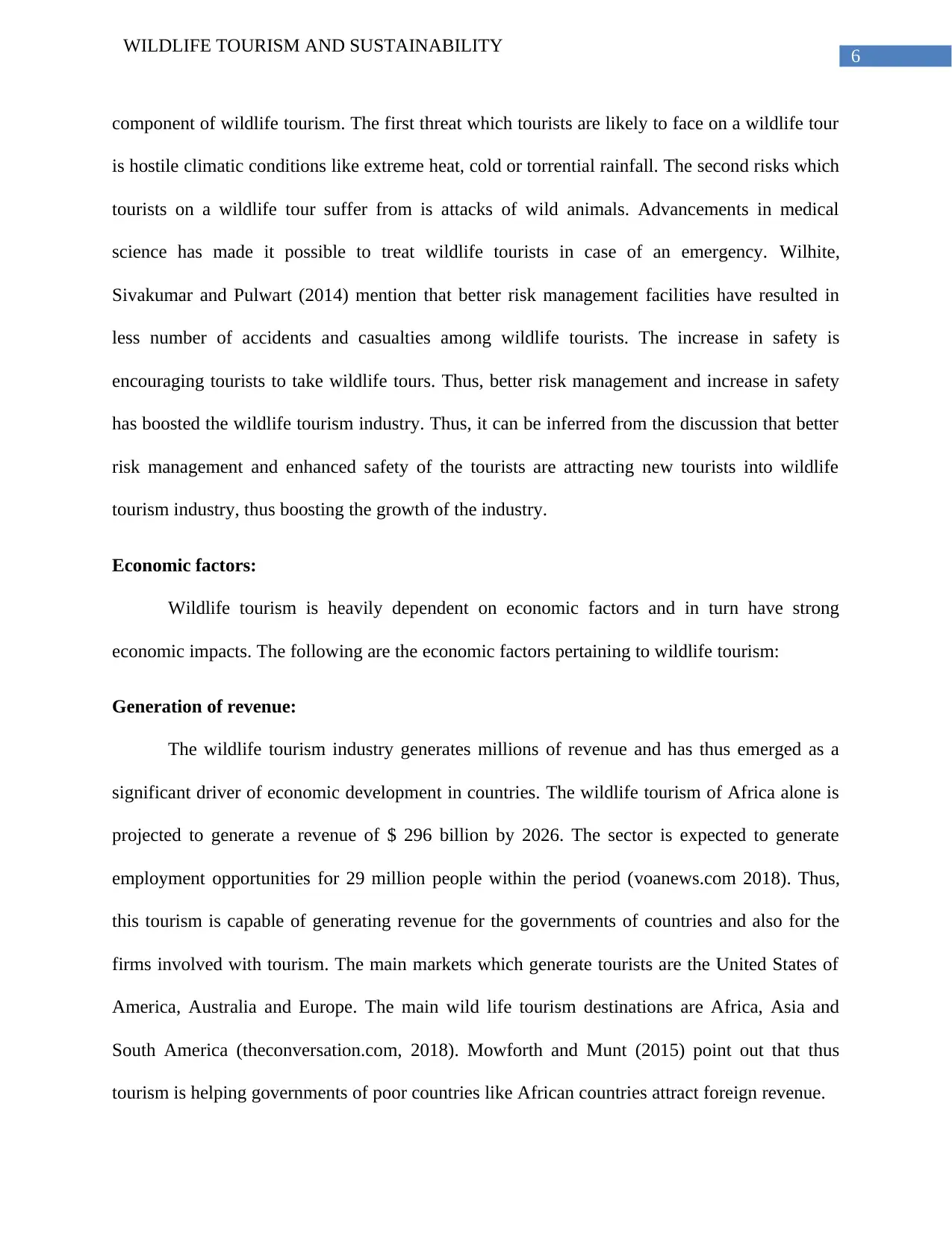
6
WILDLIFE TOURISM AND SUSTAINABILITY
component of wildlife tourism. The first threat which tourists are likely to face on a wildlife tour
is hostile climatic conditions like extreme heat, cold or torrential rainfall. The second risks which
tourists on a wildlife tour suffer from is attacks of wild animals. Advancements in medical
science has made it possible to treat wildlife tourists in case of an emergency. Wilhite,
Sivakumar and Pulwart (2014) mention that better risk management facilities have resulted in
less number of accidents and casualties among wildlife tourists. The increase in safety is
encouraging tourists to take wildlife tours. Thus, better risk management and increase in safety
has boosted the wildlife tourism industry. Thus, it can be inferred from the discussion that better
risk management and enhanced safety of the tourists are attracting new tourists into wildlife
tourism industry, thus boosting the growth of the industry.
Economic factors:
Wildlife tourism is heavily dependent on economic factors and in turn have strong
economic impacts. The following are the economic factors pertaining to wildlife tourism:
Generation of revenue:
The wildlife tourism industry generates millions of revenue and has thus emerged as a
significant driver of economic development in countries. The wildlife tourism of Africa alone is
projected to generate a revenue of $ 296 billion by 2026. The sector is expected to generate
employment opportunities for 29 million people within the period (voanews.com 2018). Thus,
this tourism is capable of generating revenue for the governments of countries and also for the
firms involved with tourism. The main markets which generate tourists are the United States of
America, Australia and Europe. The main wild life tourism destinations are Africa, Asia and
South America (theconversation.com, 2018). Mowforth and Munt (2015) point out that thus
tourism is helping governments of poor countries like African countries attract foreign revenue.
WILDLIFE TOURISM AND SUSTAINABILITY
component of wildlife tourism. The first threat which tourists are likely to face on a wildlife tour
is hostile climatic conditions like extreme heat, cold or torrential rainfall. The second risks which
tourists on a wildlife tour suffer from is attacks of wild animals. Advancements in medical
science has made it possible to treat wildlife tourists in case of an emergency. Wilhite,
Sivakumar and Pulwart (2014) mention that better risk management facilities have resulted in
less number of accidents and casualties among wildlife tourists. The increase in safety is
encouraging tourists to take wildlife tours. Thus, better risk management and increase in safety
has boosted the wildlife tourism industry. Thus, it can be inferred from the discussion that better
risk management and enhanced safety of the tourists are attracting new tourists into wildlife
tourism industry, thus boosting the growth of the industry.
Economic factors:
Wildlife tourism is heavily dependent on economic factors and in turn have strong
economic impacts. The following are the economic factors pertaining to wildlife tourism:
Generation of revenue:
The wildlife tourism industry generates millions of revenue and has thus emerged as a
significant driver of economic development in countries. The wildlife tourism of Africa alone is
projected to generate a revenue of $ 296 billion by 2026. The sector is expected to generate
employment opportunities for 29 million people within the period (voanews.com 2018). Thus,
this tourism is capable of generating revenue for the governments of countries and also for the
firms involved with tourism. The main markets which generate tourists are the United States of
America, Australia and Europe. The main wild life tourism destinations are Africa, Asia and
South America (theconversation.com, 2018). Mowforth and Munt (2015) point out that thus
tourism is helping governments of poor countries like African countries attract foreign revenue.
Paraphrase This Document
Need a fresh take? Get an instant paraphrase of this document with our AI Paraphraser
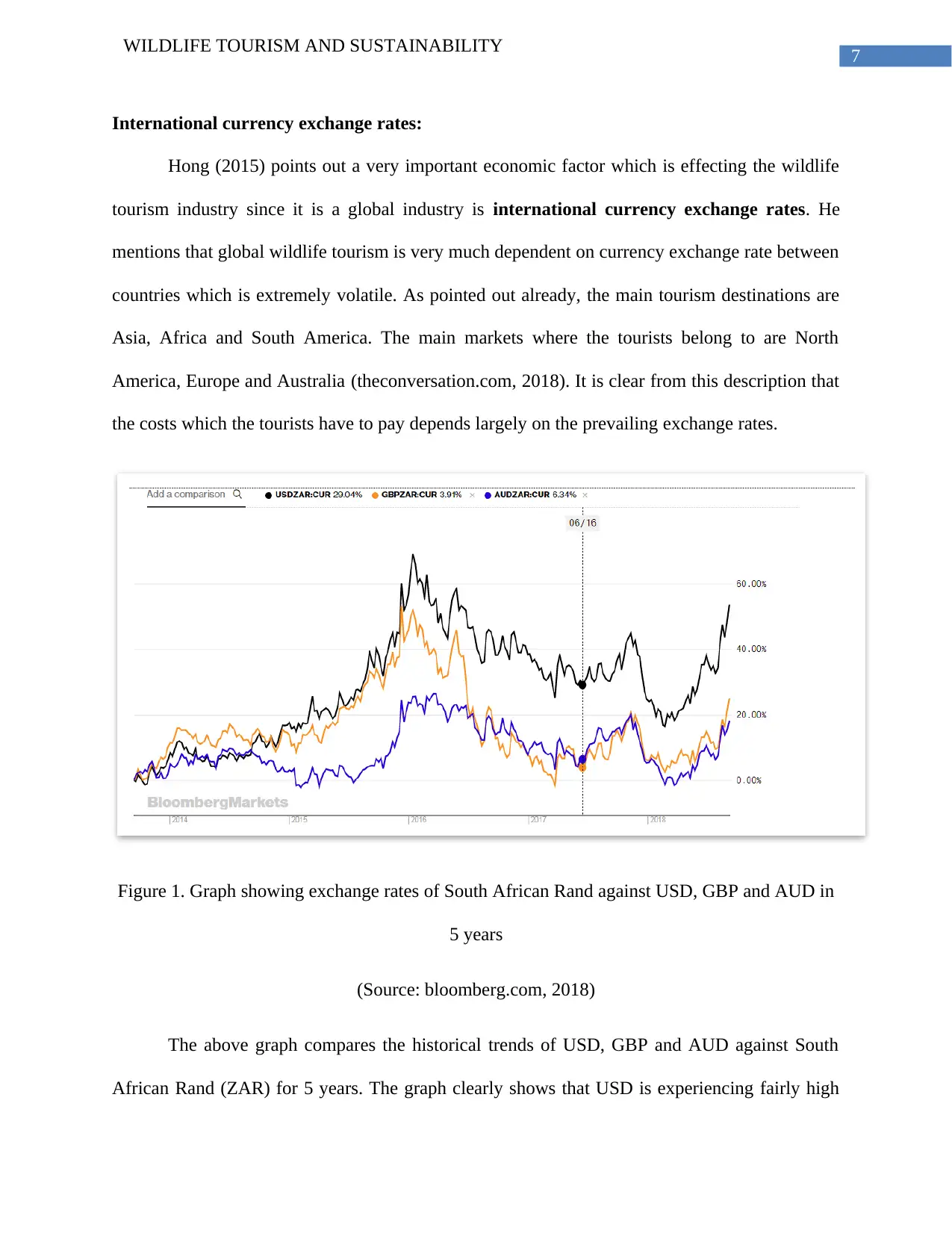
7
WILDLIFE TOURISM AND SUSTAINABILITY
International currency exchange rates:
Hong (2015) points out a very important economic factor which is effecting the wildlife
tourism industry since it is a global industry is international currency exchange rates. He
mentions that global wildlife tourism is very much dependent on currency exchange rate between
countries which is extremely volatile. As pointed out already, the main tourism destinations are
Asia, Africa and South America. The main markets where the tourists belong to are North
America, Europe and Australia (theconversation.com, 2018). It is clear from this description that
the costs which the tourists have to pay depends largely on the prevailing exchange rates.
Figure 1. Graph showing exchange rates of South African Rand against USD, GBP and AUD in
5 years
(Source: bloomberg.com, 2018)
The above graph compares the historical trends of USD, GBP and AUD against South
African Rand (ZAR) for 5 years. The graph clearly shows that USD is experiencing fairly high
WILDLIFE TOURISM AND SUSTAINABILITY
International currency exchange rates:
Hong (2015) points out a very important economic factor which is effecting the wildlife
tourism industry since it is a global industry is international currency exchange rates. He
mentions that global wildlife tourism is very much dependent on currency exchange rate between
countries which is extremely volatile. As pointed out already, the main tourism destinations are
Asia, Africa and South America. The main markets where the tourists belong to are North
America, Europe and Australia (theconversation.com, 2018). It is clear from this description that
the costs which the tourists have to pay depends largely on the prevailing exchange rates.
Figure 1. Graph showing exchange rates of South African Rand against USD, GBP and AUD in
5 years
(Source: bloomberg.com, 2018)
The above graph compares the historical trends of USD, GBP and AUD against South
African Rand (ZAR) for 5 years. The graph clearly shows that USD is experiencing fairly high
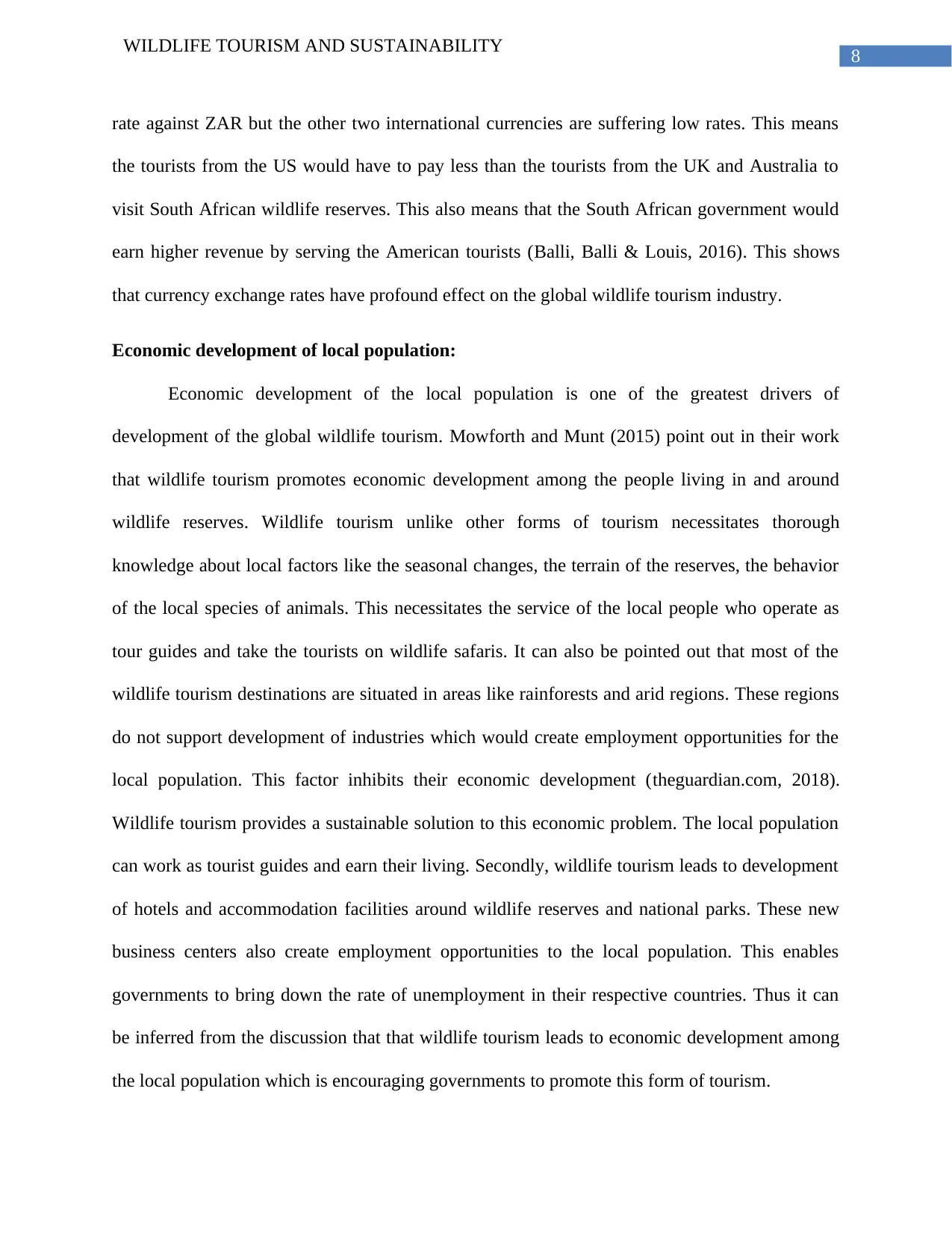
8
WILDLIFE TOURISM AND SUSTAINABILITY
rate against ZAR but the other two international currencies are suffering low rates. This means
the tourists from the US would have to pay less than the tourists from the UK and Australia to
visit South African wildlife reserves. This also means that the South African government would
earn higher revenue by serving the American tourists (Balli, Balli & Louis, 2016). This shows
that currency exchange rates have profound effect on the global wildlife tourism industry.
Economic development of local population:
Economic development of the local population is one of the greatest drivers of
development of the global wildlife tourism. Mowforth and Munt (2015) point out in their work
that wildlife tourism promotes economic development among the people living in and around
wildlife reserves. Wildlife tourism unlike other forms of tourism necessitates thorough
knowledge about local factors like the seasonal changes, the terrain of the reserves, the behavior
of the local species of animals. This necessitates the service of the local people who operate as
tour guides and take the tourists on wildlife safaris. It can also be pointed out that most of the
wildlife tourism destinations are situated in areas like rainforests and arid regions. These regions
do not support development of industries which would create employment opportunities for the
local population. This factor inhibits their economic development (theguardian.com, 2018).
Wildlife tourism provides a sustainable solution to this economic problem. The local population
can work as tourist guides and earn their living. Secondly, wildlife tourism leads to development
of hotels and accommodation facilities around wildlife reserves and national parks. These new
business centers also create employment opportunities to the local population. This enables
governments to bring down the rate of unemployment in their respective countries. Thus it can
be inferred from the discussion that that wildlife tourism leads to economic development among
the local population which is encouraging governments to promote this form of tourism.
WILDLIFE TOURISM AND SUSTAINABILITY
rate against ZAR but the other two international currencies are suffering low rates. This means
the tourists from the US would have to pay less than the tourists from the UK and Australia to
visit South African wildlife reserves. This also means that the South African government would
earn higher revenue by serving the American tourists (Balli, Balli & Louis, 2016). This shows
that currency exchange rates have profound effect on the global wildlife tourism industry.
Economic development of local population:
Economic development of the local population is one of the greatest drivers of
development of the global wildlife tourism. Mowforth and Munt (2015) point out in their work
that wildlife tourism promotes economic development among the people living in and around
wildlife reserves. Wildlife tourism unlike other forms of tourism necessitates thorough
knowledge about local factors like the seasonal changes, the terrain of the reserves, the behavior
of the local species of animals. This necessitates the service of the local people who operate as
tour guides and take the tourists on wildlife safaris. It can also be pointed out that most of the
wildlife tourism destinations are situated in areas like rainforests and arid regions. These regions
do not support development of industries which would create employment opportunities for the
local population. This factor inhibits their economic development (theguardian.com, 2018).
Wildlife tourism provides a sustainable solution to this economic problem. The local population
can work as tourist guides and earn their living. Secondly, wildlife tourism leads to development
of hotels and accommodation facilities around wildlife reserves and national parks. These new
business centers also create employment opportunities to the local population. This enables
governments to bring down the rate of unemployment in their respective countries. Thus it can
be inferred from the discussion that that wildlife tourism leads to economic development among
the local population which is encouraging governments to promote this form of tourism.
⊘ This is a preview!⊘
Do you want full access?
Subscribe today to unlock all pages.

Trusted by 1+ million students worldwide
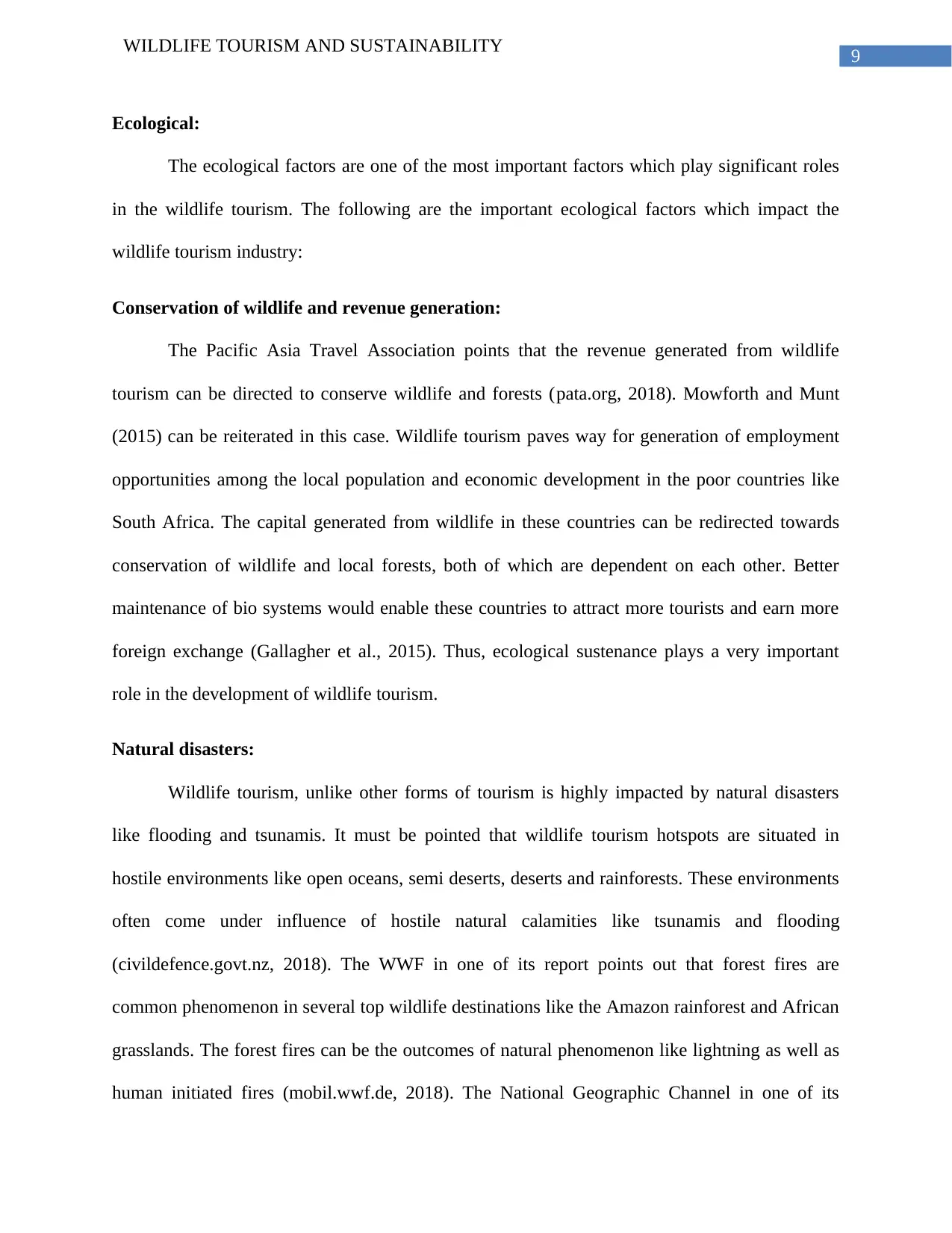
9
WILDLIFE TOURISM AND SUSTAINABILITY
Ecological:
The ecological factors are one of the most important factors which play significant roles
in the wildlife tourism. The following are the important ecological factors which impact the
wildlife tourism industry:
Conservation of wildlife and revenue generation:
The Pacific Asia Travel Association points that the revenue generated from wildlife
tourism can be directed to conserve wildlife and forests (pata.org, 2018). Mowforth and Munt
(2015) can be reiterated in this case. Wildlife tourism paves way for generation of employment
opportunities among the local population and economic development in the poor countries like
South Africa. The capital generated from wildlife in these countries can be redirected towards
conservation of wildlife and local forests, both of which are dependent on each other. Better
maintenance of bio systems would enable these countries to attract more tourists and earn more
foreign exchange (Gallagher et al., 2015). Thus, ecological sustenance plays a very important
role in the development of wildlife tourism.
Natural disasters:
Wildlife tourism, unlike other forms of tourism is highly impacted by natural disasters
like flooding and tsunamis. It must be pointed that wildlife tourism hotspots are situated in
hostile environments like open oceans, semi deserts, deserts and rainforests. These environments
often come under influence of hostile natural calamities like tsunamis and flooding
(civildefence.govt.nz, 2018). The WWF in one of its report points out that forest fires are
common phenomenon in several top wildlife destinations like the Amazon rainforest and African
grasslands. The forest fires can be the outcomes of natural phenomenon like lightning as well as
human initiated fires (mobil.wwf.de, 2018). The National Geographic Channel in one of its
WILDLIFE TOURISM AND SUSTAINABILITY
Ecological:
The ecological factors are one of the most important factors which play significant roles
in the wildlife tourism. The following are the important ecological factors which impact the
wildlife tourism industry:
Conservation of wildlife and revenue generation:
The Pacific Asia Travel Association points that the revenue generated from wildlife
tourism can be directed to conserve wildlife and forests (pata.org, 2018). Mowforth and Munt
(2015) can be reiterated in this case. Wildlife tourism paves way for generation of employment
opportunities among the local population and economic development in the poor countries like
South Africa. The capital generated from wildlife in these countries can be redirected towards
conservation of wildlife and local forests, both of which are dependent on each other. Better
maintenance of bio systems would enable these countries to attract more tourists and earn more
foreign exchange (Gallagher et al., 2015). Thus, ecological sustenance plays a very important
role in the development of wildlife tourism.
Natural disasters:
Wildlife tourism, unlike other forms of tourism is highly impacted by natural disasters
like flooding and tsunamis. It must be pointed that wildlife tourism hotspots are situated in
hostile environments like open oceans, semi deserts, deserts and rainforests. These environments
often come under influence of hostile natural calamities like tsunamis and flooding
(civildefence.govt.nz, 2018). The WWF in one of its report points out that forest fires are
common phenomenon in several top wildlife destinations like the Amazon rainforest and African
grasslands. The forest fires can be the outcomes of natural phenomenon like lightning as well as
human initiated fires (mobil.wwf.de, 2018). The National Geographic Channel in one of its
Paraphrase This Document
Need a fresh take? Get an instant paraphrase of this document with our AI Paraphraser
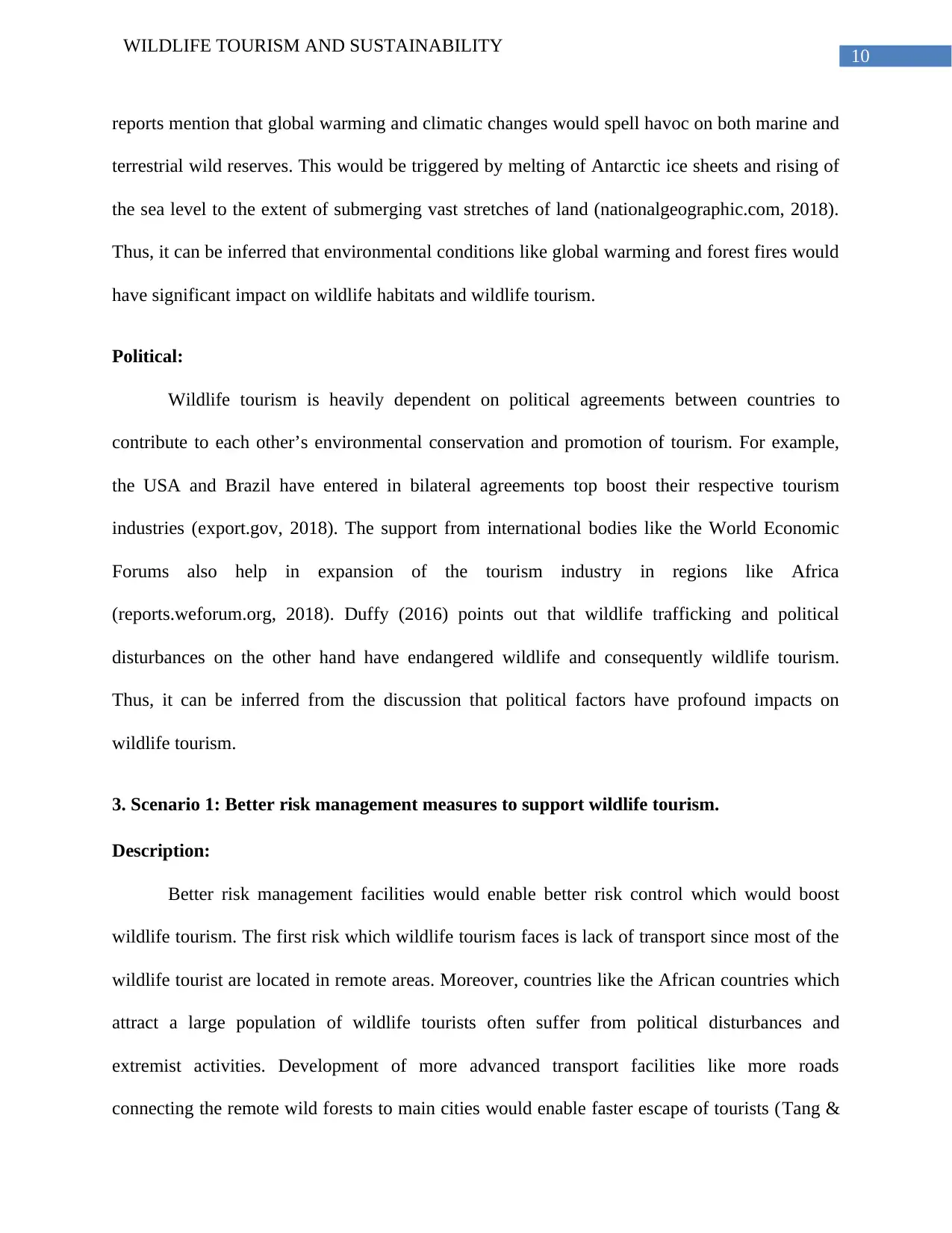
10
WILDLIFE TOURISM AND SUSTAINABILITY
reports mention that global warming and climatic changes would spell havoc on both marine and
terrestrial wild reserves. This would be triggered by melting of Antarctic ice sheets and rising of
the sea level to the extent of submerging vast stretches of land (nationalgeographic.com, 2018).
Thus, it can be inferred that environmental conditions like global warming and forest fires would
have significant impact on wildlife habitats and wildlife tourism.
Political:
Wildlife tourism is heavily dependent on political agreements between countries to
contribute to each other’s environmental conservation and promotion of tourism. For example,
the USA and Brazil have entered in bilateral agreements top boost their respective tourism
industries (export.gov, 2018). The support from international bodies like the World Economic
Forums also help in expansion of the tourism industry in regions like Africa
(reports.weforum.org, 2018). Duffy (2016) points out that wildlife trafficking and political
disturbances on the other hand have endangered wildlife and consequently wildlife tourism.
Thus, it can be inferred from the discussion that political factors have profound impacts on
wildlife tourism.
3. Scenario 1: Better risk management measures to support wildlife tourism.
Description:
Better risk management facilities would enable better risk control which would boost
wildlife tourism. The first risk which wildlife tourism faces is lack of transport since most of the
wildlife tourist are located in remote areas. Moreover, countries like the African countries which
attract a large population of wildlife tourists often suffer from political disturbances and
extremist activities. Development of more advanced transport facilities like more roads
connecting the remote wild forests to main cities would enable faster escape of tourists (Tang &
WILDLIFE TOURISM AND SUSTAINABILITY
reports mention that global warming and climatic changes would spell havoc on both marine and
terrestrial wild reserves. This would be triggered by melting of Antarctic ice sheets and rising of
the sea level to the extent of submerging vast stretches of land (nationalgeographic.com, 2018).
Thus, it can be inferred that environmental conditions like global warming and forest fires would
have significant impact on wildlife habitats and wildlife tourism.
Political:
Wildlife tourism is heavily dependent on political agreements between countries to
contribute to each other’s environmental conservation and promotion of tourism. For example,
the USA and Brazil have entered in bilateral agreements top boost their respective tourism
industries (export.gov, 2018). The support from international bodies like the World Economic
Forums also help in expansion of the tourism industry in regions like Africa
(reports.weforum.org, 2018). Duffy (2016) points out that wildlife trafficking and political
disturbances on the other hand have endangered wildlife and consequently wildlife tourism.
Thus, it can be inferred from the discussion that political factors have profound impacts on
wildlife tourism.
3. Scenario 1: Better risk management measures to support wildlife tourism.
Description:
Better risk management facilities would enable better risk control which would boost
wildlife tourism. The first risk which wildlife tourism faces is lack of transport since most of the
wildlife tourist are located in remote areas. Moreover, countries like the African countries which
attract a large population of wildlife tourists often suffer from political disturbances and
extremist activities. Development of more advanced transport facilities like more roads
connecting the remote wild forests to main cities would enable faster escape of tourists (Tang &
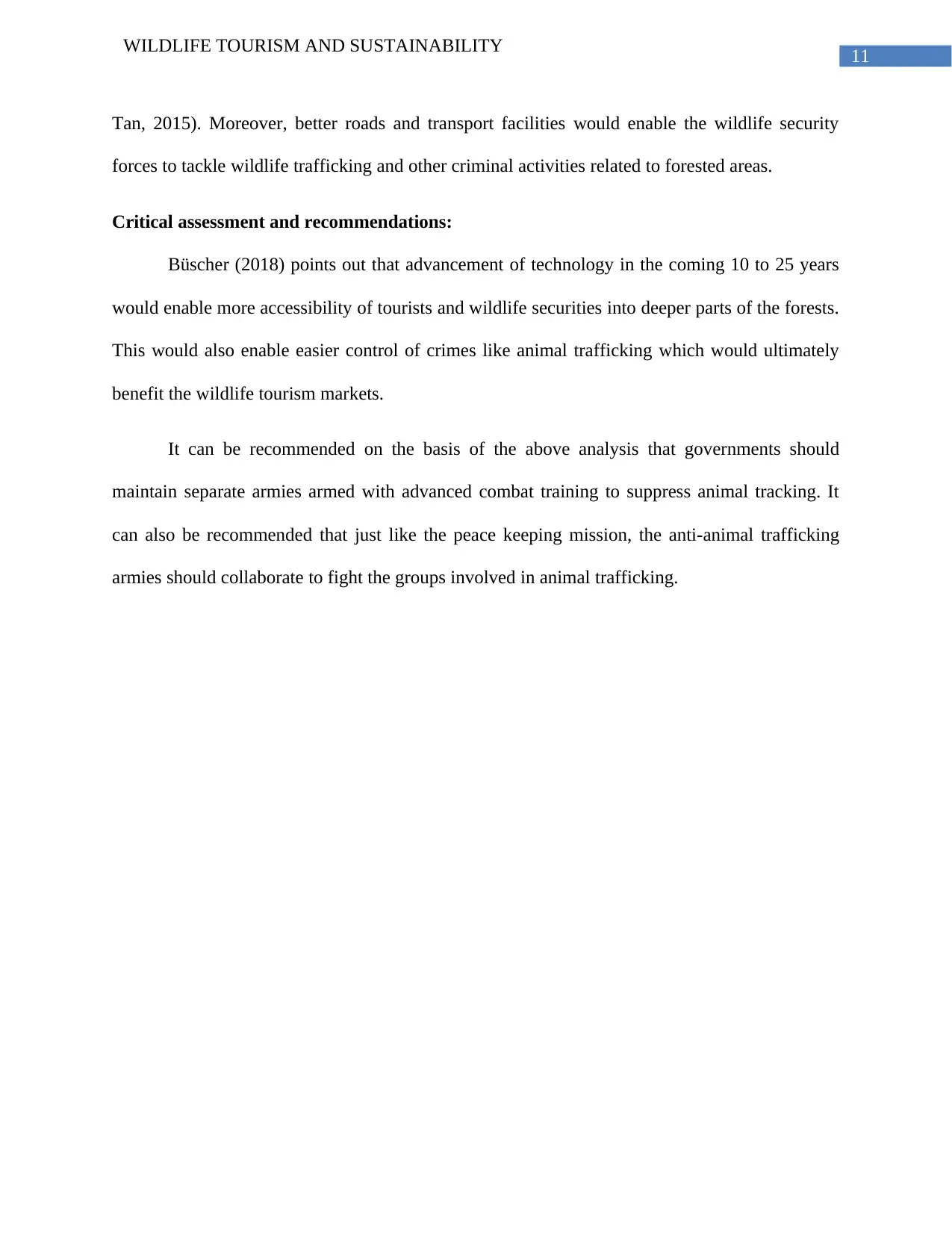
11
WILDLIFE TOURISM AND SUSTAINABILITY
Tan, 2015). Moreover, better roads and transport facilities would enable the wildlife security
forces to tackle wildlife trafficking and other criminal activities related to forested areas.
Critical assessment and recommendations:
Büscher (2018) points out that advancement of technology in the coming 10 to 25 years
would enable more accessibility of tourists and wildlife securities into deeper parts of the forests.
This would also enable easier control of crimes like animal trafficking which would ultimately
benefit the wildlife tourism markets.
It can be recommended on the basis of the above analysis that governments should
maintain separate armies armed with advanced combat training to suppress animal tracking. It
can also be recommended that just like the peace keeping mission, the anti-animal trafficking
armies should collaborate to fight the groups involved in animal trafficking.
WILDLIFE TOURISM AND SUSTAINABILITY
Tan, 2015). Moreover, better roads and transport facilities would enable the wildlife security
forces to tackle wildlife trafficking and other criminal activities related to forested areas.
Critical assessment and recommendations:
Büscher (2018) points out that advancement of technology in the coming 10 to 25 years
would enable more accessibility of tourists and wildlife securities into deeper parts of the forests.
This would also enable easier control of crimes like animal trafficking which would ultimately
benefit the wildlife tourism markets.
It can be recommended on the basis of the above analysis that governments should
maintain separate armies armed with advanced combat training to suppress animal tracking. It
can also be recommended that just like the peace keeping mission, the anti-animal trafficking
armies should collaborate to fight the groups involved in animal trafficking.
⊘ This is a preview!⊘
Do you want full access?
Subscribe today to unlock all pages.

Trusted by 1+ million students worldwide
1 out of 19
Related Documents
Your All-in-One AI-Powered Toolkit for Academic Success.
+13062052269
info@desklib.com
Available 24*7 on WhatsApp / Email
![[object Object]](/_next/static/media/star-bottom.7253800d.svg)
Unlock your academic potential
Copyright © 2020–2025 A2Z Services. All Rights Reserved. Developed and managed by ZUCOL.





